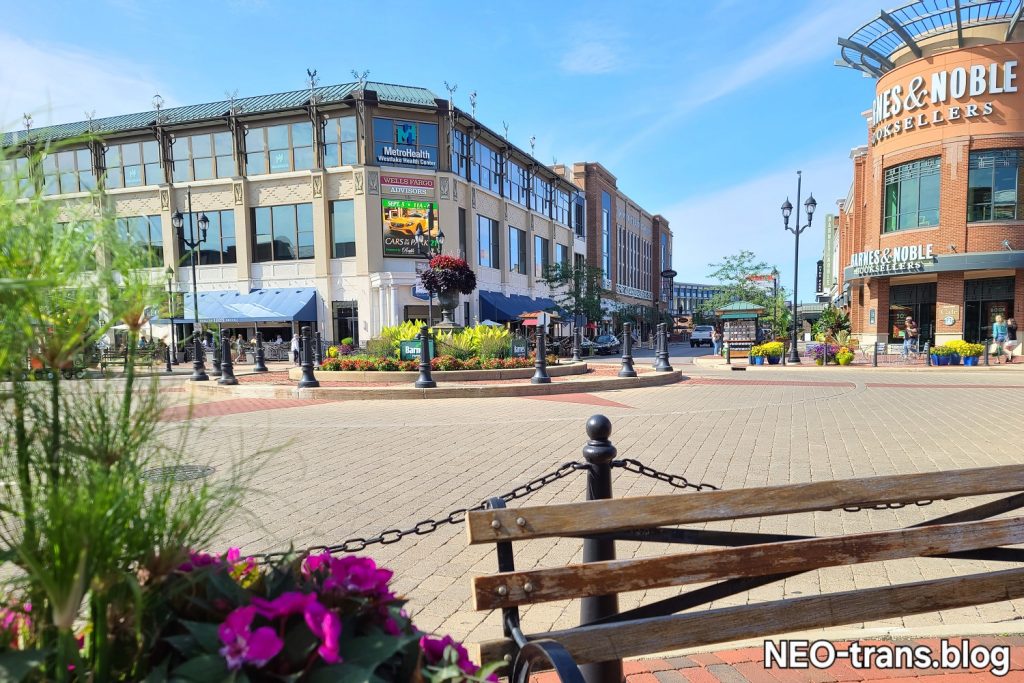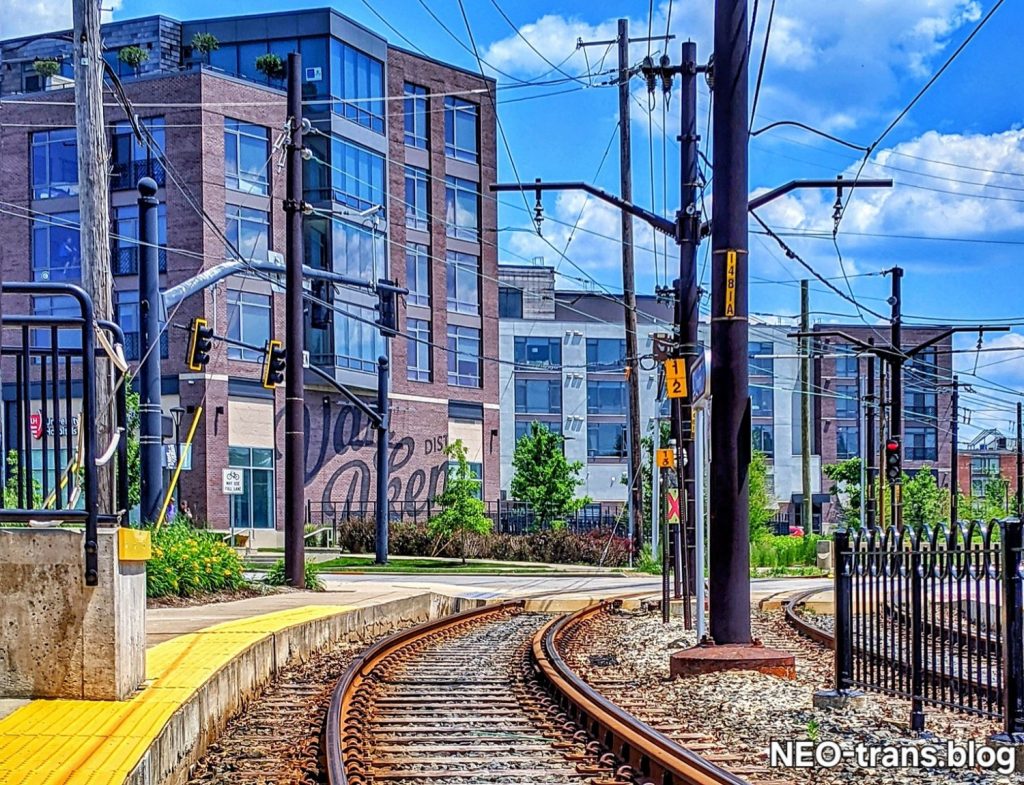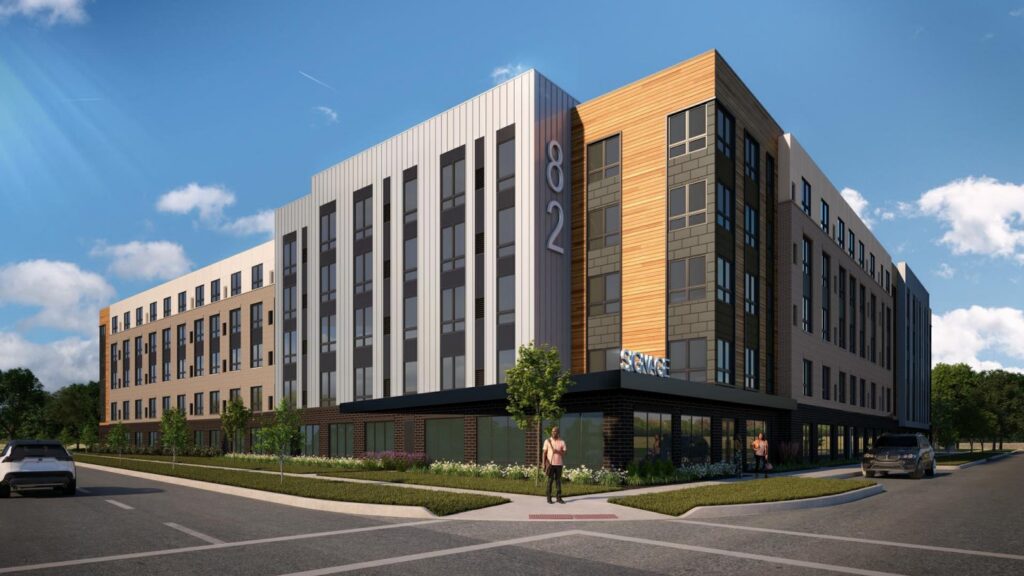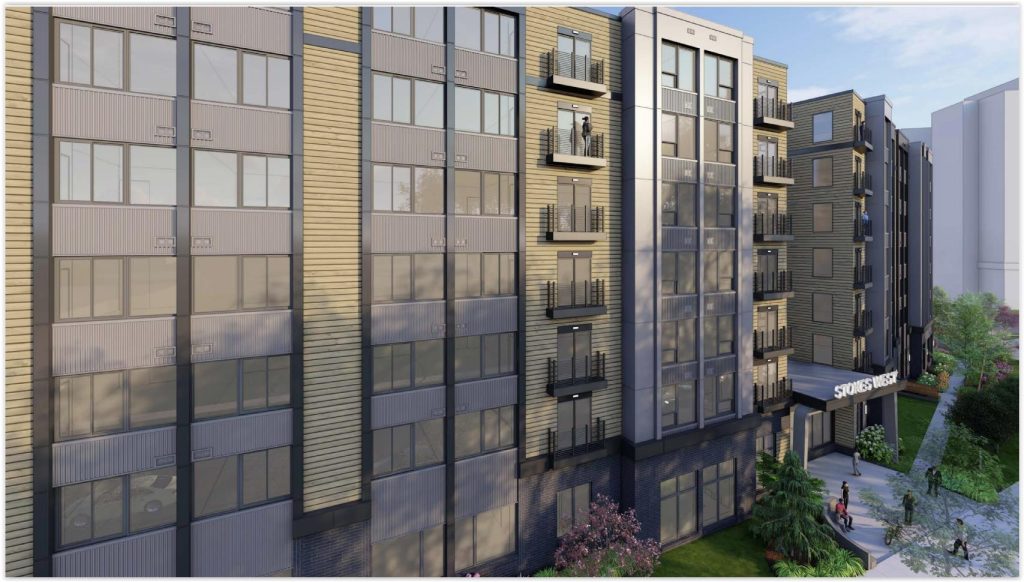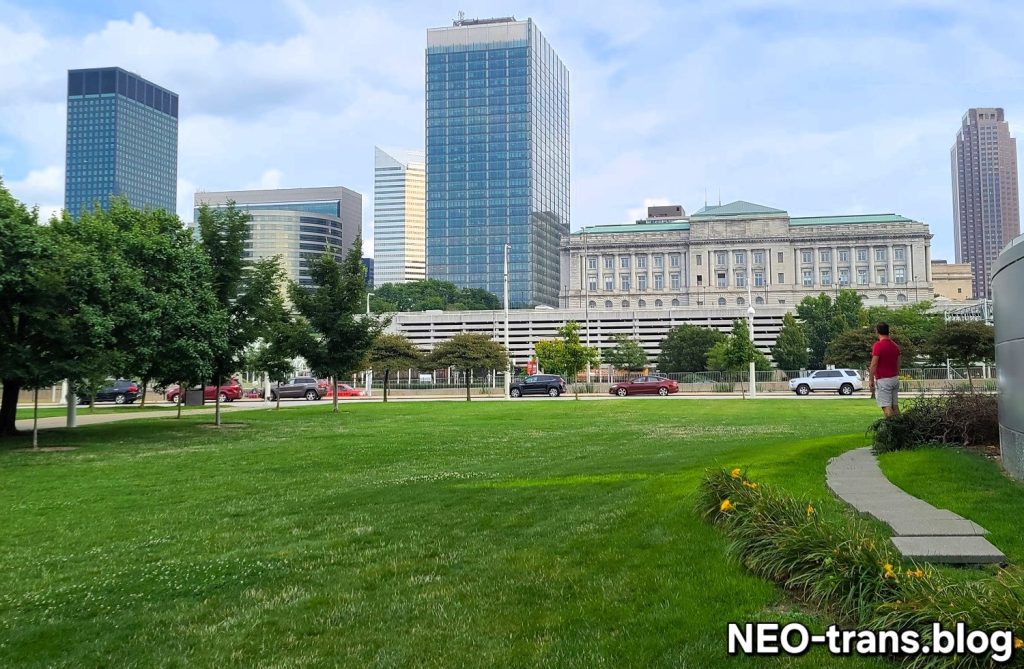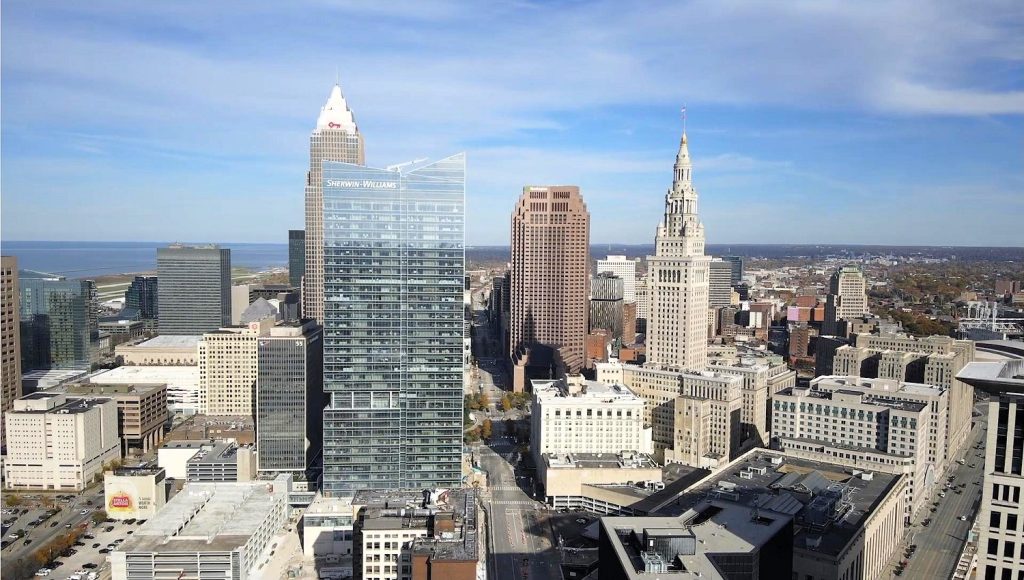
Every one of these buildings, from Cleveland’s “Big Four” in the 600-foot-plus club to the tiniest shop at the edge of downtown, has a story to tell. That story is still being written. Some added interesting plots last year. Others could take their turns in 2025. One story that is just starting is the newly built Sherwin-Williams headquarters tower (The Sherwin-Williams Company). CLICK IMAGES TO ENLARGE THEM.
Downtown, East submarkets best vs remote working
For better or worse, for richer or poorer, many of us are about to rediscover our relationship with the office. Some of us never left. Others left and aren’t coming back. But an increasing number of Americans and Greater Clevelanders will be coming back to the office in 2025, for the first time since the COVID-19 pandemic caused employers to dabble with remote or hybrid working.
Offices in much of the rest of the world are already back to pre-COVID occupancies, said Terry Coyne, vice chairman of Newmark’s Cleveland office. In some Asian cities, people are actually spending more time in the office than they did before the pandemic. Americans are less willing to return to the office because they often live in larger homes and they live farther away from work than their global counterparts.
And since the American economy has been more productive than other G7 countries, the labor market is tight, giving workers more leverage to push back on return-to-office (RTO) mandates from employers. Rather than force workers back to the office, they are trying to lure them back with financial incentives, adding office amenities and even partnering with developers to build housing within walking distance of the office.
Coyne is a big believer in retrofitting office buildings with amenities so that workers want to come to work. It comes from his experience in overseeing the office and ground-floor retail leasing at downtown’s AECOM Building, 1300 E. 9th St., plus other properties. Despite being old enough (52 years) to get regular American Association of Retired Persons mailings, the 21-story AECOM Building has a higher occupancy percentage than all but a few younger office buildings downtown.
“You have to treat your office buildings like a hotel,” Coyne said. “Rents for amenity-filled buildings are back to pre-COVID numbers. You have to appeal to people to come back work.”
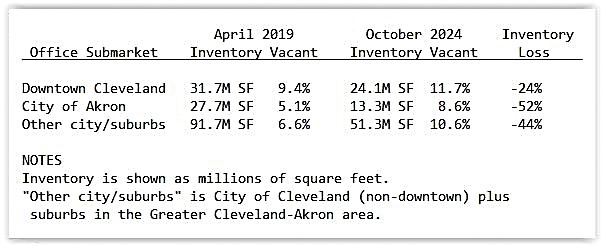
While office occupancy in Downtown Cleveland is lagging other parts of the Greater Cleveland-Akron area, it has also lost less inventory either from conversions, demolitions or simply no longer being marketed — called zombie office space. The sources for this data are from Cresco Cleveland Office Market Report April 2019 and from the Cresco Cleveland Office Market Report October 2024.
Following its $11 million renovation, the AECOM Building features a new lobby, conference center, tenant lounge, a fitness and recreation center with half basketball court, golf simulator, new locker rooms, and state-of-the-art strength and cardio equipment. Its pedestrian connection to the Westin Hotel is lined with retailers, restaurants and cafes.
Workers are going to be coming back to the office for some basic reasons, Coyne points out. Despite strong employment numbers, he believes employers have the leverage if they want to use it.
“When you work from home, you get promoted less, get fired more and you earn less,” he said. “Working together has value. We learn a ton when working from the office. A person who is 25 (years old), how do you train them when they’re working from home? That’s why companies like Amazon and JP Morgan are pushing people back into the office. I’m not sure why it took so long.”
Nathan Kelly agrees. The former head of Cresco’s Cleveland brokerage office now is president of real estate at the Playhouse Square Foundation. The foundation does more than bring big shows to the second-largest theater district in the United States. It also owns The Lumen, the tallest residential tower in Ohio. And it owns several office buildings including the Hanna and the Bulkley buildings.
“I think this is going to shift back soon,” Kelly said. “Employers are getting more serious about getting folks back into the office. And it’s not just about being there — it’s about creating spaces that people actually want to work in. Companies are putting money into better office environments and improving work culture. You know, making the office a place you want to be, not just a place you have to be.”

The interior of Sherwin-Williams’ new headquarters tower features floor-to-ceiling windows and lots of natural light. This is in the lower one-third of the tower which is farther along in its construction than the upper floors. The tower is also likely to be occupied in a similar manner, from the bottom-up throughout 2025 (The Sherwin-Williams Company).
He reminds workers, especially idealistic younger workers, that employers make the call on where people work, not employees. While having workspace flexibility is great, a company’s decision-makers determine what’s best for their business. Companies still compete for workers, but it’s just not about who pays more that lands the best talent.
“And guess what? Great office spaces in phenomenal neighborhoods are good for business,” Kelly said. “And let’s face it, the ‘work hard, play hard’ crowd still wants safety, nightlife and walkability. This is the essence of 18-hour cities like Cleveland, where you can seamlessly blend work, home, and social life within 15 minutes. Even Mayor (Justin) Bibb and Bedrock’s (CEO) Kofi Bonner have doubled down on this vision.”
While Coyne sees more companies bringing people back to the office, don’t expect to see buildings that are now 50-80 percent occupied to suddenly be bursting at the seams. The reason is two-fold, he says.
“The typical office size used to be 300 square feet per employee,” Coyne said. “Now it’s 125 (square feet). And we probably aren’t going to get everyone coming back. The new rule of thumb is that we’ll probably get back to 85-90 percent of the way we were.”
“Some roles like customer service jobs with high turnover probably aren’t coming back to the office in a big way, and that’s fine,” Kelly explained. “Not every position needs to be in person.”
And not all jobs are coming back downtown. In a country and a metro area like ours where urban sprawl and long commutes are king, they discourage people from wanting to travel, especially in bad weather, and work in an office. Kelly says that’s why more lifestyle centers like Legacy Village, Crocker Park, Pinecrest, Van Aken District, Valor Acres and the planned Browns’-affiliated developments are competing strongly for office tenants and co-working spaces.
“It’s hard to beat the authenticity and scale of what happens downtown,” he said. “But here’s the thing — right now, the suburbs are winning on office occupancy. I’ve got an unproven theory on why. The people making office location decisions? Yeah, they’re probably suburban residents themselves. They want employees in the office, but they also want a shorter commute. It’s the classic ‘work from the office but closer to home’ compromise.”
Not everything is rosy in lifestyle land, however. The post-pandemic office doldrums hit gift card-maker American Greetings in 2022, so it put up for sub-lease much of its 625,000 square-foot headquarters at the south end of Crocker Park in Westlake. Coyne described the post-pandemic suburban office market as “a bloodbath.”
Kelly notes that downtown’s success in converting old, obsolete office buildings to new uses like residential, hotel and even some updated office spaces has likely kept some employers downtown and attracted others. More old space needs to be converted, as downtown has some of the highest office vacancies in the Cleveland-Akron region, according to data from brokerage Cresco.
CrossCountry Mortgage, one of the region’s fastest growing companies, in 2022 moved its 500-employee headquarters downtown from suburban Brecksville to attract more young workers who want to work hard and play hard. CrossCountry President Ron Leonhardt and developer TurnDev are developing apartments next to the new HQ in the Superior Arts District, and marketing the apartments to CrossCountry employees and the public.
Downtown also has lost the second-least amount of office inventory of any submarket. It trails only the East submarket which is centered along the Interstate 271 corridor and includes communities like Beachwood, Highland Hills and Mayfield Heights. The East has performed the best among any submarket since the pandemic, market data shows. A big reason is that many companies’ owners and top managers live nearby.
If anything, the desire for amenity-laden office spaces in fun, safe, sociable neighborhoods that are close to home show why cities and neighborhoods exist in the first place. And it shows why the mixed-use workplace setting, be it in historic big-city or small-town downtowns or in new but traditionally designed, walkable, mixed-use lifestyle centers are resilient.
“People are social,” Coyne said. “People like to hang out with people.”
END

